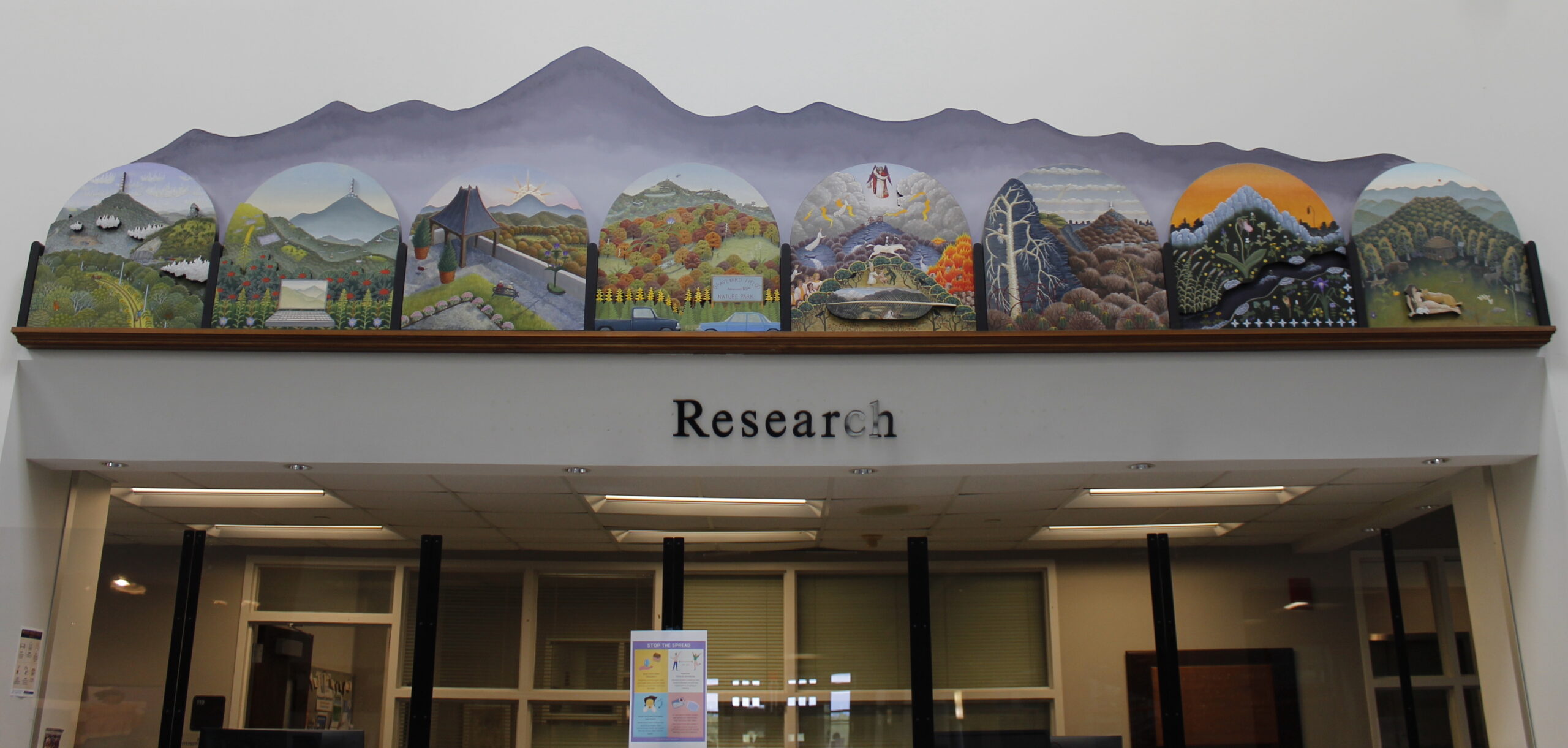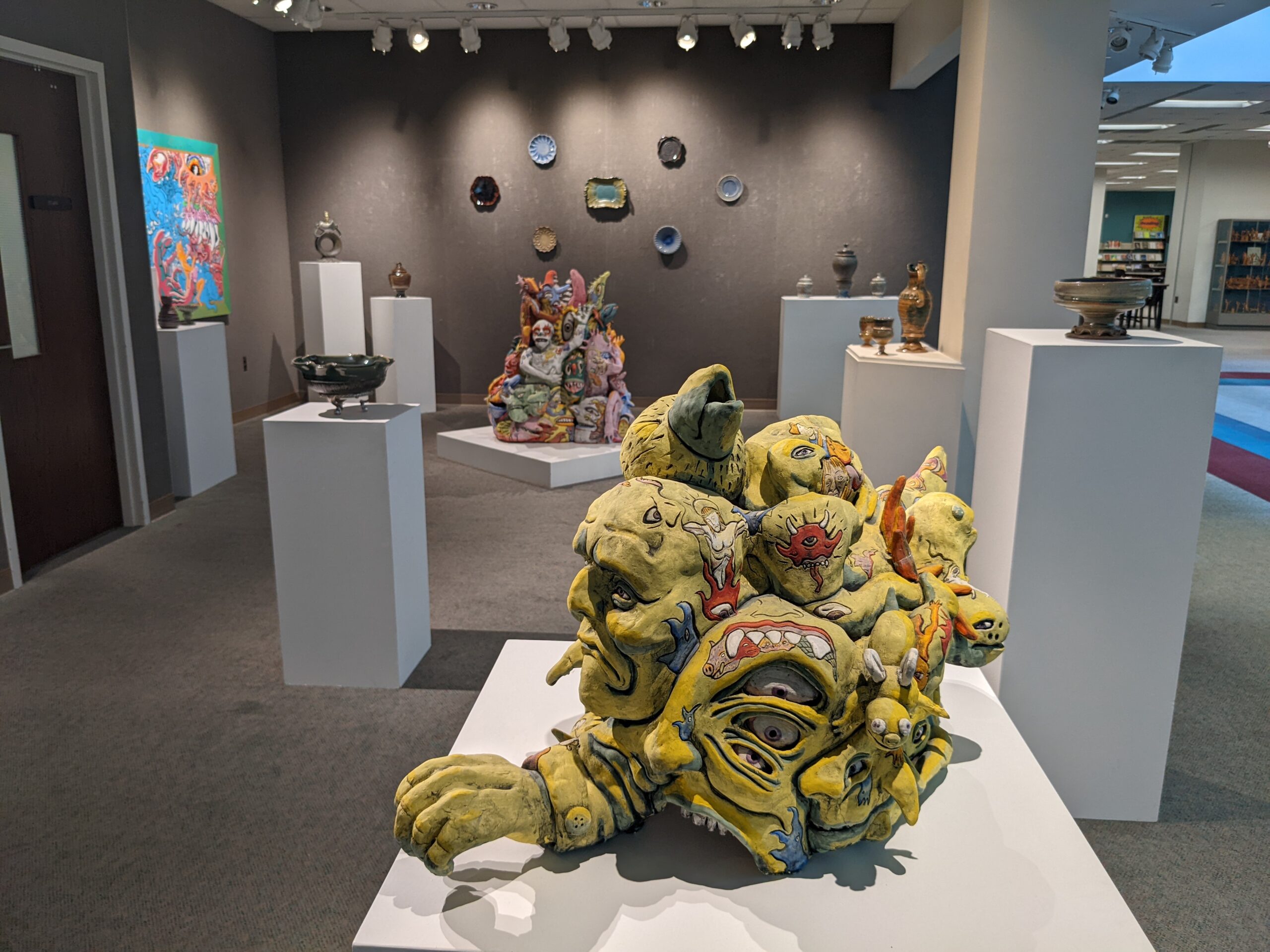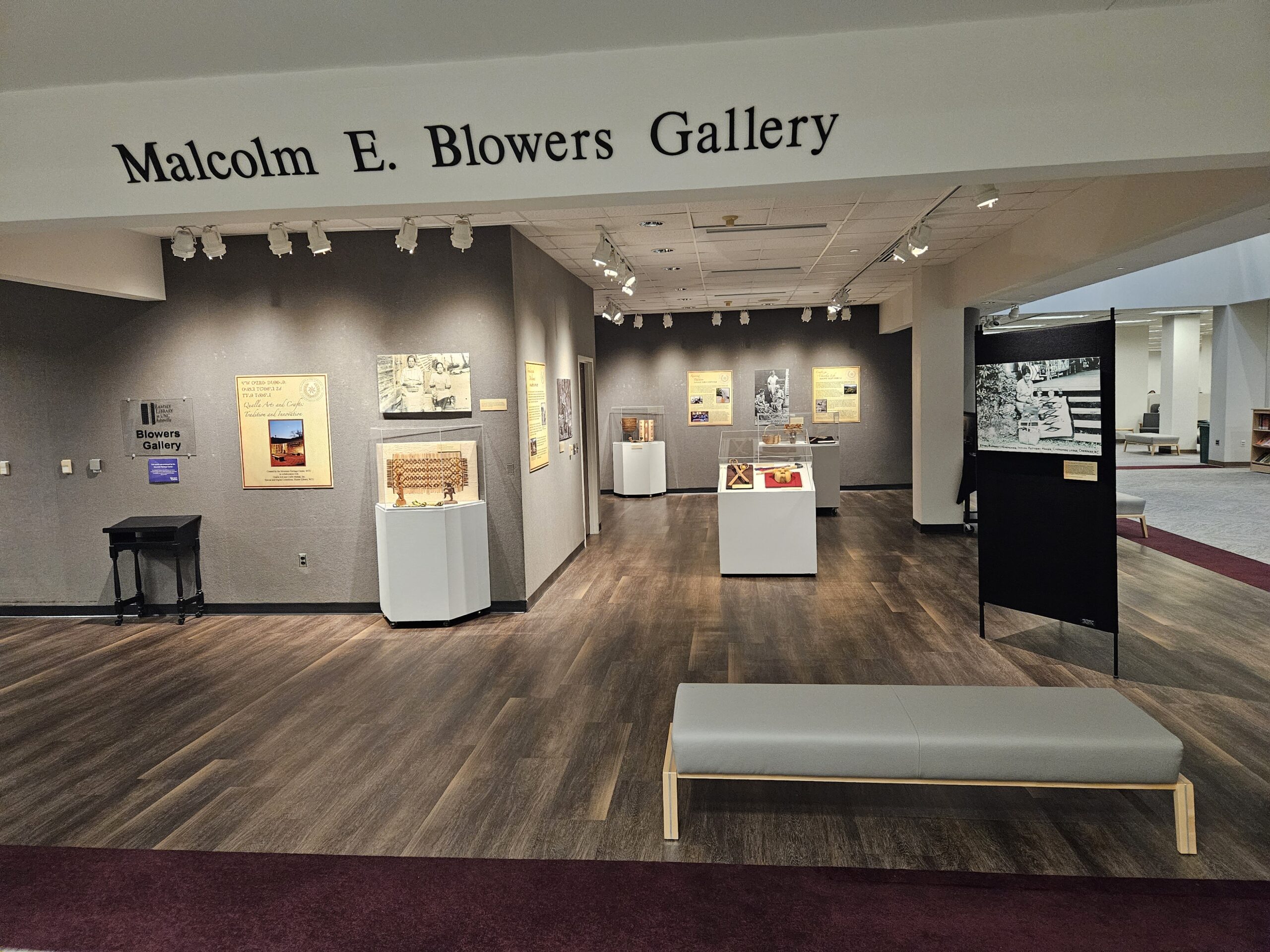The famed local artist Robert Johnson, creator of the ‘Eight Views of Mt. Pisgah’ mural in the center of Ramsey Library, passed away this August. Johnson completed installing his work in April 1997 where it still stands above our Research Desk. The mural is composed of eight panels envisioning eight possible futures for our region, seen from the same perspective as is visible from the library’s entrance, looking across UNCA’s quad to Mt. Pisgah.
In Daniels Graphics 1997 calendar: Mountain Tops-Sacred Places, Johnson said of his Mount Pisgah paintings, “I hoped to create a graphic representation of my experiences there. Some of the paintings are quite personal, and all of them reflect the interplay between the place and my thoughts.” Johnson’s commission to create the mural for Ramsey Library came from the Artworks State Buildings program, funded by one-half of one percent of the Ramsey Library construction project.
A memorial retrospective of Johnson’s work will run at the Blue Spiral Gallery in downtown Asheville from September 3 – October 29, 2021 (details here). Robert Johnson was well known for his narrative observations on societal and environmental issues, which often incorporated a sense of irony and gentle humor. For more information on Robert Johnson, please see his personal website and his recent profile by Blue Ridge Public Radio.
For those curious as to the meaning and history of the mural, the full video of Johnson’s unveiling and dedication in Ramsey Library on April 4th, 1997 is viewable below and is followed by a full transcript with details of the panels. This video is part of Ramsey Library’s YouTube channel of films made by our own internal Video Production Studio. See more here.
Here is a transcript of Johnson’s dedication with image details interspersed:
“Let me tell you how this particular mural came about. My work tends to be very narrative. In other words I like to tell stories in my paintings, which I think is very appropriate for the library. So I didn’t hold back on the narrative part of it. They all have stories connected with them and I wanted to put a lot of detail in there.
When I came into the library one day it was very crowded here at the reference desk. People were waiting. I wanted to offer something that people could look at so they wouldn’t be bored standing in line while waiting to get their reference material. I wanted to put a lot of stuff in there that would entertain as well as have something pretty to look at in the library.
Hopefully the mural can be taken on several levels. First of all, just as pretty pictures, nice color, there are flowers, nice nature scenes. You can come in and if you look at it quickly, hopefully, you can enjoy it on that level, nicely decorative.
But there is also a lot more going on in there too. The idea that evolved stemmed from my liking – I’ve done murals in houses and public buildings – and one of my real interests is in the natural environment, how people relate to the natural environment. And one of my interests was to see how this library related to the natural environment. And the one feature of the natural environment that this library relates to the most is Mount Pisgah. I’m sure you’ve noticed as you walk out the front door, you look right over the quadrangle and you see this ridgeline and Mount Pisgah is the dominant mountain. Obviously when the architect situated the building and thought of it, you know, put it up on this platform, that looking out on Mount Pisgah and that view is very important.
So I wanted to emphasize that connection of Mount Pisgah with the library. The silhouette behind there is what you see when you look out the library. It’s kind of like bringing the outside inside, connecting the site with the building.
So I started reading about Mount Pisgah. Why is it called Mount Pisgah? I found out that Mount Pisgah is named after Mount Pisgah in the Bible. Mount Pisgah in the Bible is where Moses stood and saw the Promised Land. Of course he never got into the Promised Land, but he looked into the Promised Land, essentially into the future of his people.
So it got me in mind of thinking about the future, and all the different visions of the future that are floating around in our culture, and I thought I’d try to gather them together in some sort of orderly way. So I did a lot of reading and talking to a lot of people, and in my mind anyway there were eight distinct and different visions of the future. I wanted to tie them to Mount Pisgah.
Mount Pisgah is of course in a National Forest right now. So the idea is each one of these (eight segments of the mural) represents a vision of the future and how that future would affect an area like Mount Pisgah, a beautiful natural area. What would that look like? In my fantasy kind of way, each one of these is a different vision. It’s not essentially a political diatribe I’m trying to get across here. In all these visions there are positive and negative elements.
What I wanted to do tonight is go through them quickly. Let’s start at the left. If you’ll look at them closely, there are two panels that represent the summer. Two that represent fall, two that represent winter and two that represent spring. So we go through the year that way.
The summer panels are sort of a vision of the future that represent what is happening now: the current use of natural areas.
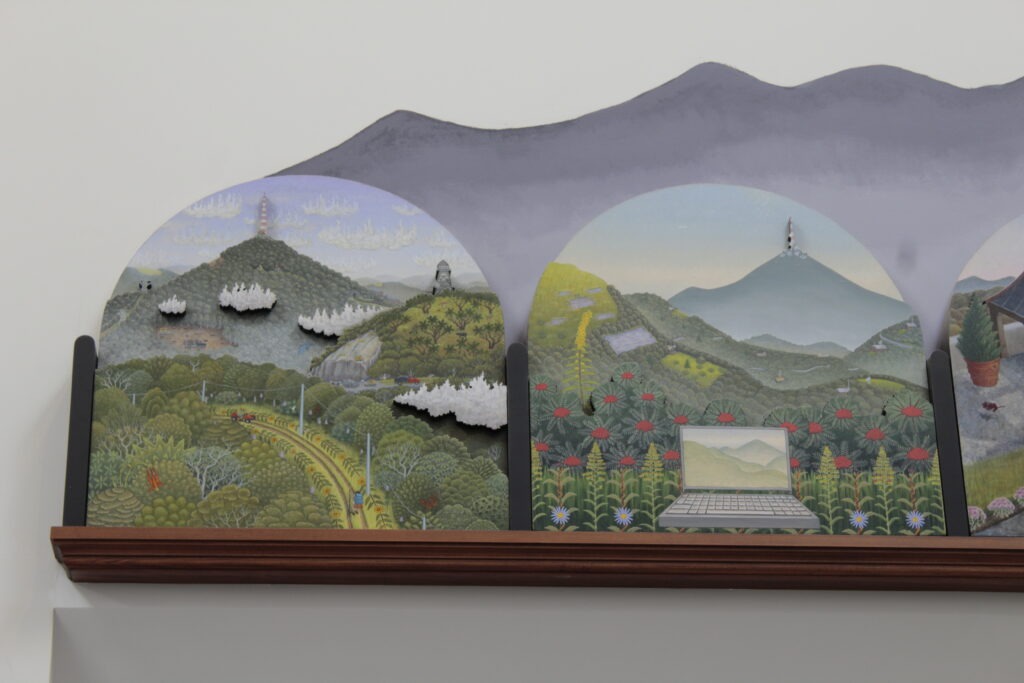
The first one is government-managed multiple use. It’s managed by the Forest Service and the idea is to satisfy a wide range of uses. There is a little bit of mining, a little bit of logging, a little mountain bike riding, a little four-wheeling, a little hiking. I tried to throw everything in there that was going on, and my vision of the future would be that there is more of what is now going on, diversity. There are real positive elements in that. It satisfies a lot of people. But it’s all very oriented toward use. That’s the way people are thinking about it, and I think it would be very easy for it to get overused in lots of different ways.
The second vision of the future is another thing that is happening right now. You probably have friends that have moved to this area because they have been able to bring their jobs with them. They’ve been able to bring their jobs because of the Information Age. That’s what I call the Information Age future. They’ve been able to hook up to their business using computers through satellite dishes and so forth. They’ve been able to do their work there. Nature in an area like Mount Pisgah becomes sort of a backdrop for them to do their real work which takes place in cyberspace. This is a whole different relationship to the natural environment from what the traditional culture has experienced around here. There’s not that sort of real physical connection to nature. There’s a loss of connection, but they want to keep it esthetically beautiful as a very nice place to live, a positive aspect.
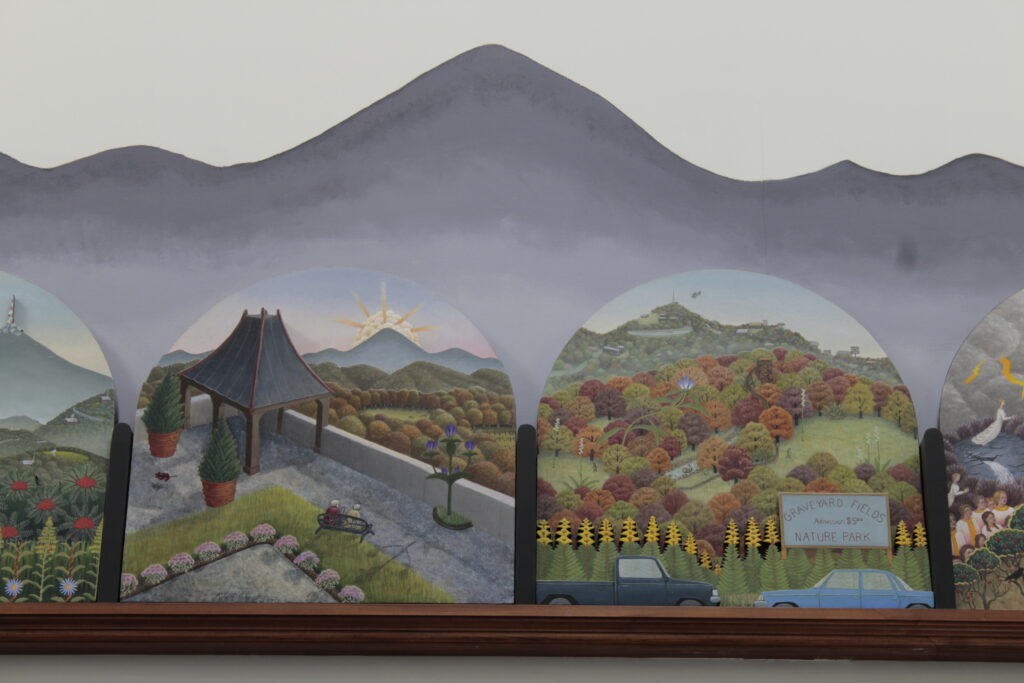
The next one is an aristocratic future. That’s a fall vision. My fall futures are kind of visions of the past, old visions of how to manage a natural area. Mount Pisgah used to be owned by George Vanderbilt. Essentially, Vanderbilt owned his view. Everything you could see from Biltmore House he owned – everything between the house and Mount Pisgah. He had a hunting lodge up there where he could go and spend some time. Factions in our society see certain aristocratic groups, those with a lot of money, buying up huge tracts of land and managing huge tracts, which is sad for those who don’t have money or aren’t connected with it because they don’t have access. But on the other hand Vanderbilt really managed his land very, very well. He brought over a forester from Germany to improve timber product practices. There are positive and negative elements to that also.
The fourth one is what I call a free enterprise future. There are certain segments in our society that believe that the government really shouldn’t own land. It should be privately owned and developed for essentially commercial use. That’s my vision of what Mount Pisgah would look like. One of my favorite areas, one I loved to hang around, is Graveyard Fields. It’s almost like a natural little park. It’s my vision that someone would buy up Graveyard Fields and make a Nature Park out of it, put in a little golf course, and a little tubing down the river and up on the parkway it’s just full of billboards and motels. This is essentially free enterprise without any sort of controls on it.
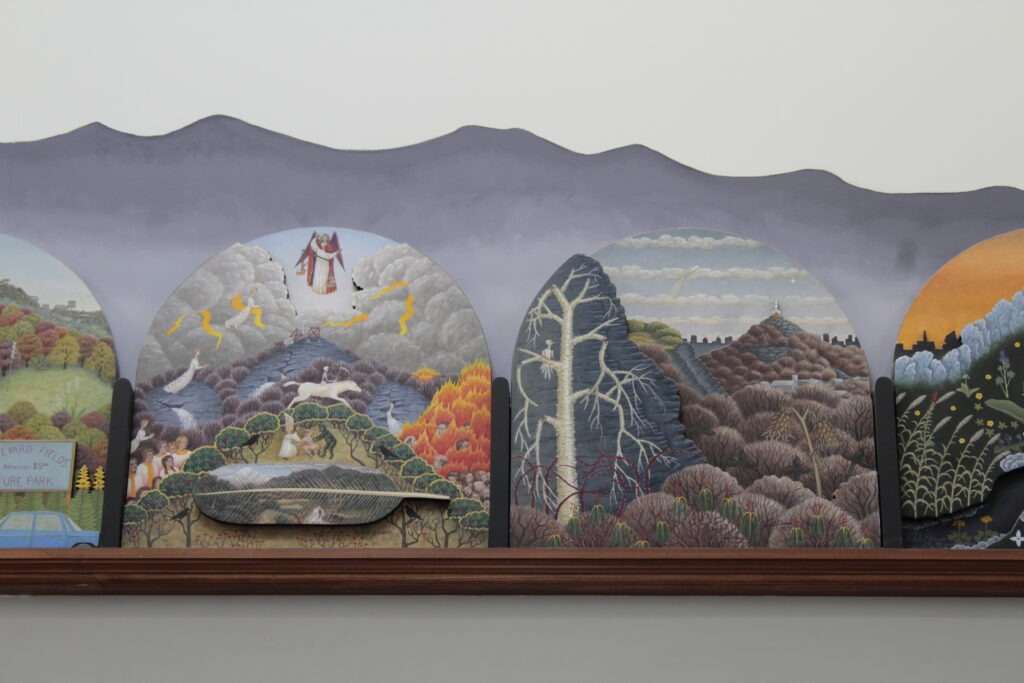
The next two are pretty grave visions of the future. Those are my winter scenes. The first is the apocalyptic future. In our culture there are basically two strong strands of apocalyptic thought. One comes from fairly fundamentalist religions, Christian, Islamic or whatever. There will be a huge apocalypse: earthquakes and lightnings. That’s are a lot of images from the Book of Revelations. Things are going to fall apart but there is going to be this new future that takes place afterwards. It’s going to be this wonderful place. This new future is going to take place up in Heaven, up in the sky. The totally different strain of apocalyptic future that I’ve run into, that’s sort of a New Age, Native American based idea of the future. Earth changes, there will be all these dramatic changes in the Earth, everything is going to fall apart, but things are going to start over again and there’s going to be this wonderful world after that. The main difference is that wonderful world is going to take place right here on Earth. Thats what I tried to represent by the feather, there. Actually that’s a copy of a Frederick Church painting from down in Ecuador but it looked like someone’s vision of what a huge, beautiful new natural area would look like.
The next one’s an interesting one. It’s what I call my Silver Seed future. I’ve run into this. There are people in our culture who actually believe that we don’t have to worry about the natural environment, that we can just let it go exploit it as much as we can, let it get polluted. The only thing we have to do when it gets to be unlivable here on Earth, we’ll ge in our rocket ships and go off, find another planet and start all over again. Sort of an offshoot on this is you run out of certain minerals on Earth and you do your mining on other planets and bring it back to Earth. We don’t particularly have to worry about our resources on Earth.
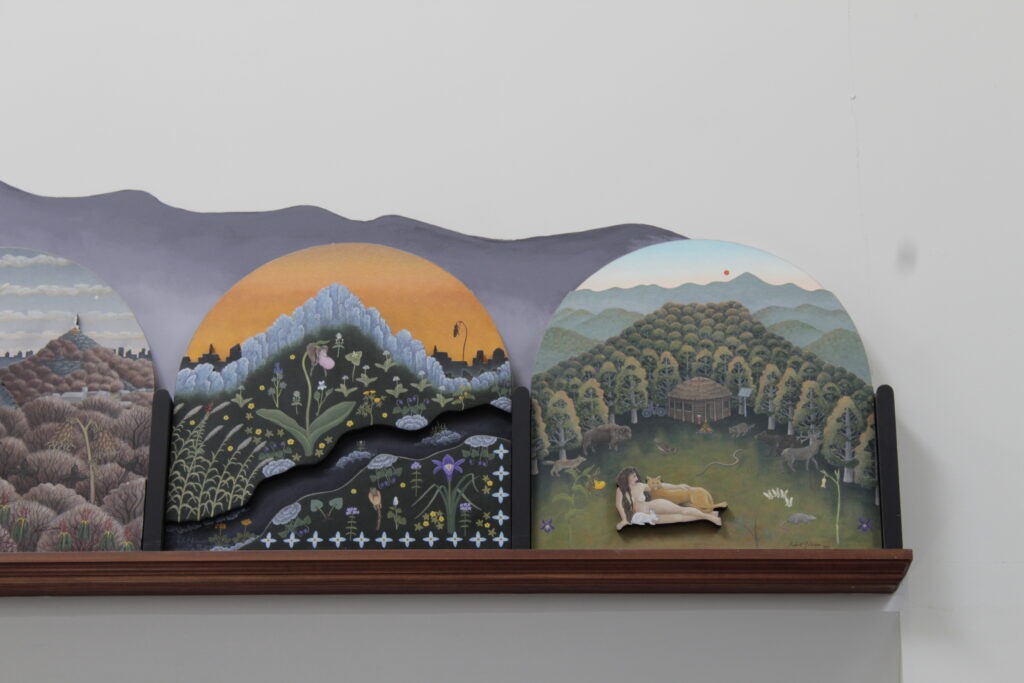
Then I get into my more positive ones that are springtime paintings. The first is what I call Preservationist Future. This is a vision of Mount Pisgah that is probably espoused by mainstream environmentalist groups, the Wilderness Society, Sierra Club and so forth. It has a lot of positive aspects to it. An area like Mount Pisgah should be preserved in its most pristine state. We should have areas like this in the natural environment that aren’t disturbed at all. But then what happens to the rest of the world, like down in the valley, here in Asheville? There may be minor changes that take place but essentially civilization goes on as usual. I’m representing the contrast between the Lady Slipper up in the preserved area which is
pristine and then down in the valley where there is uncontrolled growth and pollution. Lady Slippers aren’t doing so well down there. That’s the positive and negative aspects of that.
Then the last one is what I call my Deep Ecology, Eco-Feminist future. It’s tied into the image of the Peaceable Kingdom. That’s where I got a lot of these images. It’s the very idealized vision that
Earth’s population is reduced by a great amount, the native animals that once lived here have all been brought back-like the buffalo and and the elk and people are living in harmony with the natural
environment-very, very simply. Our natural consumption has been cut down. We are doing everything with appropriate technologies this little bicycle, this little solar panel up there. Construction is all out of native material. And we’re living on an equal basis with nature around us, not a human centered culture, but one that’s centered on the whole ecosystem around us, on an equal basis. That’s probably the most positive vision of the future that I ran across, but it seems way off in the distance and not easily achievable.
So that basically represents the research that I’ve done, all these visions of the future that are floating around today.”
